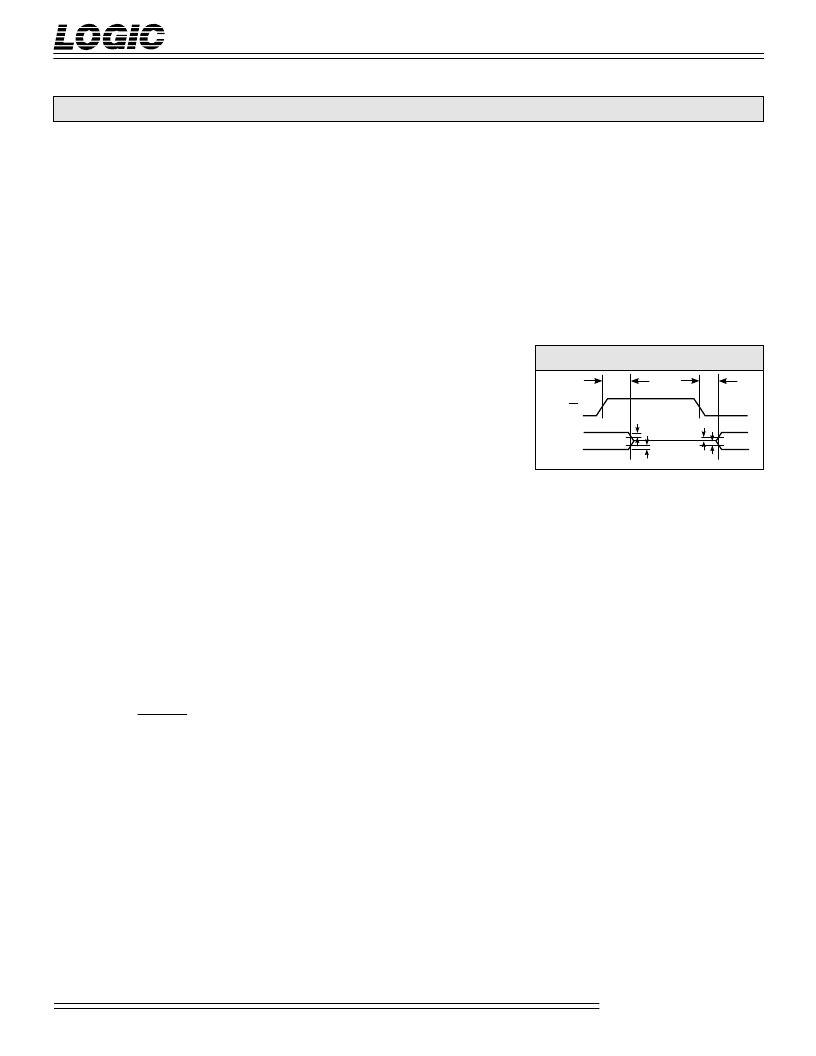- 您現(xiàn)在的位置:買賣IC網(wǎng) > PDF目錄358052 > LPR521KMB24 (LOGIC DEVICES INC) 16-BIT, DSP-PIPELINE REGISTER, CQCC44 PDF資料下載
參數(shù)資料
| 型號(hào): | LPR521KMB24 |
| 廠商: | LOGIC DEVICES INC |
| 元件分類: | 數(shù)字信號(hào)處理外設(shè) |
| 英文描述: | 16-BIT, DSP-PIPELINE REGISTER, CQCC44 |
| 封裝: | CERAMIC, LCC-44 |
| 文件頁數(shù): | 4/6頁 |
| 文件大?。?/td> | 132K |
| 代理商: | LPR521KMB24 |

DEVICES INCORPORATED
LPR520/521
4 x 16-bit Multilevel Pipeline Register
06/30/95–LDS.P520/1-K
4
Pipeline Registers
NCV F
4
1. Maximum Ratings indicate stress
specifications only. Functional oper-
ation of these products at values be-
yond those indicated in the Operating
Conditions table is not implied. Expo-
sure to maximum rating conditions for
extended periods may affect reliability.
2. The products described by this spec-
ification include internal circuitry de-
signed to protect the chip from damag-
ing substrate injection currents and ac-
cumulations of static charge. Never-
theless, conventional precautions
should be observed during storage,
handling, and use of these circuits in
order to avoid exposure to excessive
electrical stress values.
3. This device provides hard clamping
of transient undershoot and overshoot.
Input levels below ground or above
V
CC
will be clamped beginning at –0.6 V and
V
CC
+ 0.6 V. The device can withstand
indefinite operation with inputs in the
range of –0.5 V to +7.0 V. Device opera-
tion will not be adversely affected, how-
ever, input current levels will be well in
excess of 100 mA.
4. Actual test conditions may vary
from those designated but operation is
guaranteed as specified.
5. Supply current for a given applica-
tion can be accurately approximated
by:
where
N = total number of device outputs
C = capacitive load per output
V = supply voltage
F = clock frequency
6. Tested with all outputs changing ev-
ery cycle and no load, at a 5 MHz clock
rate.
7. Tested with all inputs within 0.1 V of
V
CC
or Ground, no load.
8. These parameters are guaranteed
but not 100% tested.
9. AC specifications are tested with
input transition times less than 3 ns,
output reference levels of 1.5 V (except
t
ENA
/
t
DIS
test), and input levels of
nominally 0 to 3.0 V. Output loading
may be a resistive divider which
provides for specified
I
OH
and
I
OL
at an
output voltage of
V
OH
min and
V
OL
max respectively. Alternatively, a
diode bridge with upper and lower
current sources of
I
OH
and
I
OL
respectively, and a balancing voltage of
1.5 V may be used. Parasitic
capacitance is 30 pF minimum, and
may be distributed. For
t
ENABLE
and
t
DISABLE
measurements, the load
current is increased to 10 mA to reduce
the RC delay component of the
measurement.
This device has high-speed outputs ca-
pable of large instantaneous current
pulses and fast turn-on/turn-off times.
As a result, care must be exercised in
the testing of this device. The following
measures are recommended:
a. A 0.1 μF ceramic capacitor should be
installed between
V
CC
and Ground
leads as close to the Device Under Test
(DUT) as possible. Similar capacitors
should be installed between device
V
CC
and the tester common, and device
ground and tester common.
b. Ground and
V
CC
supply planes
must be brought directly to the DUT
socket or contactor fingers.
c. Input voltages should be adjusted to
compensate for inductive ground and
V
CC
noise to maintain required DUT
input levels relative to the DUT ground
pin.
10. Each parameter is shown as a min-
imum or maximum value. Input re-
quirements are specified from the point
of view of the external system driving
the chip. Setup time, for example, is
specified as a minimum since the exter-
nal system must supply at least that
much time to meet the worst-case re-
quirements of all parts. Responses from
the internal circuitry are specified from
the point of view of the device. Output
delay, for example, is specified as a
maximum since worst-case operation of
any device always provides data within
that time.
11. Transition is measured ±200 mV
from steady-state voltage with speci-
fied loading.
12. These parameters are only tested at
the high temperature extreme, which is
the worst case for leakage current.
NOTES
HIGH IMPEDANCE
OE
TRISTATE
OUTPUTS
0.2 V
0.2 V
t
ENA
t
DIS
0.2 V
0.2 V
F
IGURE
1.
T
HRESHOLD
L
EVELS
相關(guān)PDF資料 |
PDF描述 |
|---|---|
| LPS5018CTE100M | 1 ELEMENT, 10 uH, FERRITE-CORE, GENERAL PURPOSE INDUCTOR, SMD |
| LPS5018CTE2R2M | 1 ELEMENT, 2.2 uH, FERRITE-CORE, GENERAL PURPOSE INDUCTOR, SMD |
| LPS5728CTE220M | 1 ELEMENT, 22 uH, FERRITE-CORE, GENERAL PURPOSE INDUCTOR, SMD |
| LPS5728CBK330M | 1 ELEMENT, 33 uH, FERRITE-CORE, GENERAL PURPOSE INDUCTOR, SMD |
| LPS6926CBK330M | 1 ELEMENT, 33 uH, FERRITE-CORE, GENERAL PURPOSE INDUCTOR, SMD |
相關(guān)代理商/技術(shù)參數(shù) |
參數(shù)描述 |
|---|---|
| LPR521KMB30 | 制造商:未知廠家 制造商全稱:未知廠家 功能描述:Pipeline Register |
| LPR521KME24 | 制造商:未知廠家 制造商全稱:未知廠家 功能描述:Pipeline Register |
| LPR521KME30 | 制造商:未知廠家 制造商全稱:未知廠家 功能描述:Pipeline Register |
| LPR521PC15 | 制造商:未知廠家 制造商全稱:未知廠家 功能描述:Pipeline Register |
| LPR521PC22 | 制造商:未知廠家 制造商全稱:未知廠家 功能描述:Pipeline Register |
發(fā)布緊急采購,3分鐘左右您將得到回復(fù)。